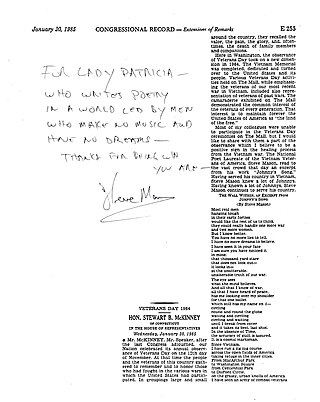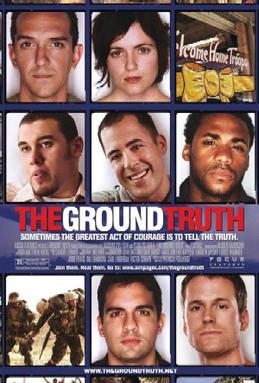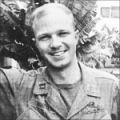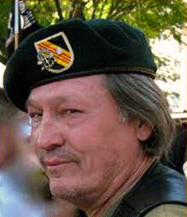
The Vietnam Veterans Memorial is a U.S. national memorial in Washington, D.C., honoring service members of the U.S. armed forces who served in the Vietnam War. The two-acre (8,100 m2) site is dominated by two black granite walls engraved with the names of those service members who died or remain missing as a result of their service in Vietnam and South East Asia during the war. The Wall, completed in 1982, has since been supplemented with the statue Three Soldiers in 1984 and the Vietnam Women's Memorial in 1993.
Cornelius Mahoney Sheehan was an American journalist. As a reporter for The New York Times in 1971, Sheehan obtained the classified Pentagon Papers from Daniel Ellsberg. His series of articles revealed a secret United States Department of Defense history of the Vietnam War and led to a U.S. Supreme Court case, New York Times Co. v. United States, 403 U.S. 713 (1971), which invalidated the United States government's use of a restraining order to halt publication.

Vietnam Veterans of America, Inc. (VVA) is a national non-profit corporation founded in 1978 in the United States that is committed to serving the needs of all veterans. It is funded without any contribution from any branch of government. VVA is the only such organization chartered by the United States Congress and dedicated to Vietnam veterans and their families. The group holds a congressional charter under Title 36 of the United States Code. Its founding principle is, "Never again will one generation of veterans abandon another."

Three Soldiers is a bronze statue by Frederick Hart. Unveiled on Veterans Day, November 11, 1984, on the National Mall in Washington, D.C., it is part of the Vietnam Veterans Memorial commemorating the Vietnam War. It was the first representation of an African American on the National Mall.

Steve Mason was a decorated United States Army captain, combat veteran of the Vietnam War, critically acclaimed poet and the Poet Laureate of the Vietnam Veterans of America.

The Vietnam Veterans Memorial Fund, Inc. (VVMF), is the non-profit organization established on April 27, 1979, by Jan Scruggs, a former Army Infantry in Vietnam. Others veterans joined including, Jack Wheeler, and several other graduates of West Point to finance the construction of a memorial to those Americans who served or died during the Vietnam War. The memorial was not designed to make a political statement about the war itself. From this fund came the Vietnam Veterans Memorial, dedicated on Veterans Day, 1982, on the National Mall in Washington, D.C.

Vietnam Veterans Against the War (VVAW) is an American tax-exempt non-profit organization and corporation founded in 1967 to oppose the United States policy and participation in the Vietnam War. VVAW says it is a national veterans' organization that campaigns for peace, justice, and the rights of all United States military veterans. It publishes a twice-yearly newsletter, The Veteran; this was earlier published more frequently as 1st Casualty (1971–1972) and then as Winter Soldier (1973–1975).

The National World War I Memorial is a national memorial commemorating the service rendered by members of the United States Armed Forces in World War I. The 2015 National Defense Authorization Act authorized the World War I Centennial Commission to build the memorial in Pershing Park, located at 14th Street and Pennsylvania Avenue NW in Washington, D.C. The park, which has existed since 1981, also contains the John J. Pershing General of the Armies commemorative work. In January 2016, the design commission selected the submission "The Weight of Sacrifice", by a team consisting of Joseph Weishaar, Sabin Howard, Phoebe Lickwar, and GWWO Architects, as the winning design, which is expected to be completed by 2024.

The Japanese American Memorial to Patriotism During World War II is a National Park Service site to commemorate the contributions of American citizens of Japanese ancestry and their parents who patriotically supported the United States despite unjust treatment during World War II.

Captain Humbert Roque "Rocky" Versace was a United States Army officer of Puerto Rican–Italian descent who was posthumously awarded the United States' highest military decoration—the Medal of Honor—for his heroic actions while a prisoner of war (POW) during the Vietnam War. He was the first member of the U.S. Army to be awarded the Medal of Honor for actions performed in Southeast Asia while in captivity.

The Ground Truth is a 2006 documentary film about veterans of the Iraq War. It was directed and produced by Patricia Foulkrod.

Michael Shannon Davison was a United States Army four-star general, who served as Commander in Chief, United States Army Europe/Commander, Central Army Group from 1971 to 1975.
Raymond Monsour Scurfield is an American professor emeritus of social work, The University of Southern Mississippi, Gulf Coast. He retired in November, 2021 from private practice. He has continued as the external clinical consultant to the Biloxi VA Vet Center since 2011. He has been recognized for his expertise in war-related and natural disaster Psychological trauma and in meditation. He has published books and articles exploring the effects of post traumatic stress disorder (PTSD) in both combat veterans and disaster survivors, including a trilogy of books about war’s impact. The trilogy’s third installment, War Trauma: Lessons Unlearned from Vietnam to Iraq, was published in October 2006. His three newest books are Scurfield, R.M. & Platoni, K.T. (Eds.). War Trauma & Its Wake. Expanding the Circle of Healing. New York & London: Routledge (2012); Scurfield, R.M. & Platoni, K.T. (Eds).Healing War Trauma. A Handbook of Creative Approaches. New York & London (2013); and Faith-Based and Secular Meditation: Everyday and Posttraumatic Applications. Washington, D.C.: NASW Press (2019)(see review on Amazon.com books).
Dan Guenther, is an American novelist and poet. A graduate of Coe College, he has a Master of Fine Arts from the Iowa Writers' Workshop. He was a captain in the U.S. Marine Corps. His poems and letters from Vietnam, during the Vietnam War, were included in the acclaimed novel, The Stones of Summer by Dow Mossman, published by Bobbs-Merrill in 1972 and republished by Barnes & Noble in 2003. In 2002, Guenther appeared in the documentary film Stone Reader by Mark Moskowitz. The film chronicled the director's attempt to revive and have republished the acclaimed book of seemingly vanished author Dow Mossman, a lifelong friend of Dan Guenther. The revival was successful.

Arnold E. Resnicoff is an American Conservative rabbi who served as a military officer and military chaplain. He served in Vietnam and Europe before attending rabbinical school. He then served as a U.S. Navy Chaplain for almost 25 years. He promoted the creation of the Vietnam Veterans Memorial and delivered the closing prayer at its 1982 dedication. In 1984 the President of the United States spoke on his eyewitness account of the 1983 Beirut barracks bombing. After retiring from the military he was National Director of Interreligious Affairs for the American Jewish Committee and served as Special Assistant to the Secretary and Chief of Staff of the United States Air Force, serving at the equivalent military rank of Brigadier General.

Joel L. Swerdlow is an American author, editor, journalist, researcher, and educator. His works include To Heal a Nation: The Story of the Vietnam Veterans Memorial, co-authored with Jan Scruggs, which became a 1988 NBC movie. His articles have been published in American newspapers and magazines, and international publications have translated his work into more than three dozen languages for international publication. For ten years, he worked as a senior writer and assistant editor of National Geographic, and was the lead writer for the magazine's 1998–1999 Millennium series.

John Parsons Wheeler III, known as Jack Wheeler, was an American businessman and former White House aide. Wheeler was chairman of the Vietnam Veterans Memorial Fund, senior planner for Amtrak (1971–1972), official of the Securities and Exchange Commission (1978–1986), chief executive and CEO of Mothers Against Drunk Driving, consultant to the Mitre Corporation (2009–death), and a presidential aide to the Ronald Reagan, George H. W. Bush, and George W. Bush administrations. He also held numerous other positions in the United States military, government, and corporations. He died under mysterious circumstances on December 30, 2010.
William "Bill" Albracht was an Army captain in the Vietnam War. He is a recipient of three Silver Stars, and is the author of Abandoned in Hell: The Fight for Vietnam's Firebase Kate.

Theodore Lane Sampley was an American Vietnam War veteran and activist. He primarily advocated for those servicemembers still considered missing in action or prisoners of war (POW-MIA) as of the end of hostilities in 1975. A staunch political conservative, he also ran for local political office several times. He is credited with the research that identified Air Force Lt. Michael Blassie as the Vietnam fatality buried at the Tomb of the Unknown Soldier, and for his role in organizing the annual Rolling Thunder motorcycle event in Washington. In Kinston, North Carolina, where he lived for much of his adult life, he was known for his local civic activism, most notably his effort to build a replica of the Confederate ironclad CSS Neuse, the only full-size replica of a Confederate ironclad, in the city's downtown.

Alan "Ace" Cozzalio was an American army officer, primarily known for his distinguished service as a helicopter pilot in the Vietnam War. Initially nominated for the Medal of Honor, he instead received the Distinguished Service Cross as well as every lesser commendation of valor. He remained in the army, rising to the rank of Lieutenant colonel before being medically retired due to heart problems. He died six years later at the age of 46 after an unsuccessful heart transplant operation.


















